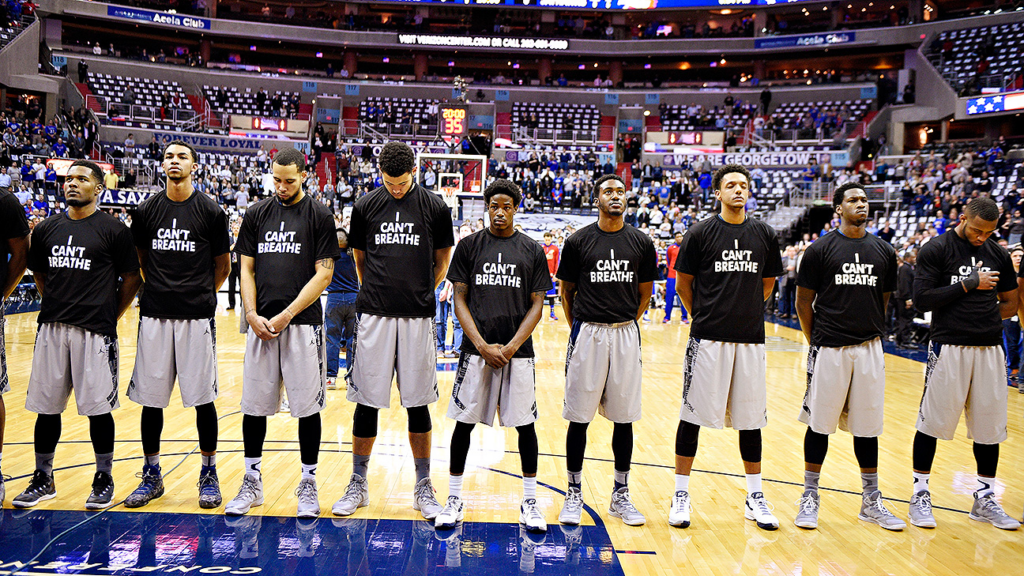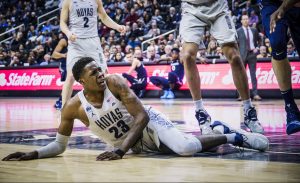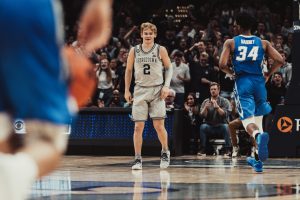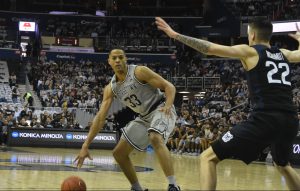This article is part 4 of “It’s A G Thing”, a 4-part series about the history of the Georgetown men’s basketball team both on and off the court. Find Part 3 here.
In recent years, the team has made strong statements on social issues. Since Coach Thompson started back in 1972, Hoyas players have been keenly aware of the platform they possess and they have used that to their advantage to shed light on police brutality and systemic racism towards African-Americans.
After the murder of Eric Garner by the New York Police Department in 2014, during which he was put in a chokehold and repeated the words “I can’t breathe” 11 times, athletes across all professional leagues made powerful statements. It was Georgetown that led the way in college basketball.
Before a showdown with No. 10 Kansas, every Hoyas player wore a shirt with the words “I Can’t Breathe” during warmups and the national anthem, showing the nation that they stood in solidarity with the many Black families who had experienced unnecessary loss at the hands of police.

Photo by Nick Wass/AP Members of the 2014-15 Georgetown men’s basketball team wore “I Can’t Breathe” shirts after the murder of Eric Garner.Photo by Nick Wass/AP
“To be honest if I’m really remembering that time, it was really a collective thing as far as the team and Coach Thompson (III),” said guard Jabril Trawick (COL ‘15). “We would be the first school to do it, and he let us talk about it as a team. So it wasn’t like it was anything forced or anything, but at the time we thought that was a great way to take a stance on what was going on in that situation to shed light on that situation.”
The issues of systemic racism and police violence once again came to the forefront after the murders of George Floyd, Breonna Taylor, and Ahmaud Arbery came to national attention. In response to the senseless killings, more than 70 Georgetown basketball alumni got on a conference call and put out a statement shared on social media.
For guard Gene Smith (COL ’84), though, statements are not enough. “Where has been the action? Where have been the boots on the ground? Maybe those are the questions we should be asking ourselves as a family,” he said.
Trawick echoes the sentiment. “We got an opportunity to make a real difference if we want to. The resources are there. It’s all about putting our minds together and making it happen.”
Smith envisions a pipeline to fast-track athletes into the business world or the coaching ranks by leveraging the Georgetown network and the brand that the university has worked hard to cultivate.
“We should have something that’s set up where the Wall Street alliance we got, whenever we go to New York, our team is meeting with all the prominent Georgetown people on Wall Street,” Smith said. “When you travel someplace, are we meeting with professionals to talk about the next stage? Is there something we have set up on campus where we’re doing career days? These are things that matter.”
To Smith, these programs also cannot simply pay lip service to the idea of Black empowerment. They must achieve results that can be measured with actionable items. According to the Wall Street Journal, only 3.2 percent of senior executive positions in the business world are held by Black people, and even those executives are perceived as a threat by their mostly-white peers.
On the coaching side of a game where nearly 80 percent of players are Black, just 18.7 percent of the coaches in men’s college basketball’s six major conferences are Black. Remove the Big East’s five Black coaches from that equation, and the number falls to 13.8 percent, according to The Shadow League. Finding a Black athletic director is even more rare, with only 17 in all of Division I, according to Global Sport Matters. Everyone agrees that this needs to change.
“I want to see how many coaches got hired in the last three years from this program,” said Smith. “Or, are these coaches going out with frequency and talking to the public, talking to young kids, paying it forward? Paying back? I would just like to see more strategies about engagement, because the athletes are the last ones to benefit for the most part.”
“I don’t believe in the token, one or two [African-American head coaches] sprinkled here, sprinkled there,” said Ewing. “There needs to be a true representation of us, other than just being the ones on the floor. The ones on the benches as well.”
To this end, Georgetown basketball has done a fine job of hiring Black coaching talent. “If you look down the bench, our whole coaching staff is African American. Our Athletic Director is one of the few African Americans in the country,” guard Jagan Mosely (MSB ’20) said. “Even though it’s a PWI (predominantly white institution), I feel as though the school does stand behind our athletes.”
For Smith, there is an internal conflict when it comes to constructive criticism of the program he loves so dearly. “You don’t wanna be that guy that’s questioning the gift or progress. I applaud those efforts,” Smith said. “I think you always need to see some elbow grease behind it.”
“There needs to be a true representation of us, other than just being the ones on the floor. The ones on the benches as well.”
Smith does not intend to bash the program he loves dearly. He simply would like to see a return to the Hoya Paranoia brand that defined the program only because he wants to see the program be successful and represent Black America once more.
“We should be doing more based on what the program did represent. I’m not sure we represent those things now. I think JT3, whether it was consciously or subconsciously, kind of got away from that,” said Smith. “I’m waiting for Patrick to trademark the program. That’s a difficult task but who better to do it than him?”
“There’s no better player experience than a top 50 player in Coach Ewing. So that’s a Hall of Famer that is actually sitting right there in front of you, trying to tell you the right way to make the NBA,” forward Jerome Williams (COL ‘96) said.
To return to its dominating ways, former players feel that connecting current players with alumni that have been in their position before is more important than securing the highest-profile recruits.
“You have to recruit a certain kind of player, or just basically have certain personnel because Georgetown is not like every other school. You’re gonna have to do your work as a player. You’re gonna have to work for a lot of stuff,” Trawick said. “I think it’s all about merging the essence from back then with the times now, because as I said earlier, it’s all about finding new ways to create solutions, and merge the bridge between the past and now, and how can we go into the future.”
“As alumni of the program, we have to be very proactive, to show what life after basketball looks like. Every player thinks they’re going to play in the NBA,” said Williams. “They don’t understand the harsh realities of making the NBA and then being able to stay in the NBA. And Georgetown has a whole list of players who made it and actually played and had long careers and then careers after.”
Back then, Georgetown and the whole Big East disrupted college basketball with their physical style of play and their winning ways. Today, individual players have become the disruptive force because of the power they hold in recruiting. “The way I see it, the NCAA is powerless without its athletes,” Mosely said. “Even if they don’t control the rules, they’re still the people that everyone pays to see.”
This statement rings especially true with the recent announcement that five-star recruit Makur Maker committed to Howard University, an HBCU. This is crucial because television stations pay schools or conferences to show their games. If more high-profile recruits follow Maker’s example, television money may provide a new revenue stream for HBCUs. Little by little, Mosely sees progress being made.
“If everyone that goes to a PWI meets up and goes to HBCUs and make HBCUs the colleges that are playing on ESPN every week, it might take some time but it will be a change for the better,” Mosely said. “Guys like Mikey Williams, who are ranked high, still have time to change the course right now.”
Mosely only wishes that the process could have started earlier with one of his best friends and high school teammates, R.J. Cole, who also committed to Howard. Unlike Maker, Cole was not a high-profile recruit. He showed schools the mistake they had made by passing on him, averaging 22.5 points per game over his two seasons at Howard and dominating the MEAC conference. He performed so well that UConn, a powerful program that showed little interest in him out of high school, picked him up as a transfer.
“I think a lot of things that go into basketball are political, so I think R.J. actually was very underrated coming out of high school,” said Mosely of Cole. “I wish that he was rated as high as he should’ve been, because then it would’ve been a bigger deal for him to go to Howard.”
Athletes like Maker and programs like Georgetown are viewed as breaking the status quo. However, this is not just an issue for college athletes. Players in the NBA bubble have made it a point to not just “shut up and dribble”, and that became even more pronounced when a police officer shot Jacob Blake seven times in front of his children.
In response, the Milwaukee Bucks refused to take the court for their playoff game with the Orlando Magic on Wednesday, August 26. Soon after, the NBA postponed all games that day, making it clear that NBA players are not expendable commodities solely here for entertainment. They are enacting the changes that some Hoyas advocated for months ago.
“If we’re really talking about making a change right now, for me personally, I think basketball is something that’s not really on the front of my list as far as things that need to be addressed,” Trawick said. “We really need to address things from the root level outside of entertainment and things of that nature.”
Smith put it more bluntly. “It is more impactful if they don’t play. I think the message is clearer if they don’t play,” he said. “The platform shit is bullshit, in terms of them playing.”
“We really need to address things from the root level outside of entertainment and things of that nature.”
In the fight for racial justice, Georgetown basketball has played a meaningful and important role in the past. Not only did they put out statements in times of adversity, they represented a whole portion of the nation with their style of play, their swagger, and their success.
Because of what the program represented and who the team was composed of, it was easy for the Black community within D.C. to embrace the Hoyas. The players feel that connection needs to be revitalized for the program to reclaim its brand.
“Georgetown is still regarded as one of the schools that deep down, a lot of African Americans support still to this day,” Williams said. “When you’re talking about helping the Black community, it’s better not to be coming around when you’re winning. It’s better to be doing what you’re doing out of the goodness of your heart and the kindness of your heart so that they know it’s true.”
For Smith, he has struggled seeing what kind of demographic the university’s social media team has catered to.
“It looks like we only had one type of fan: the fan that went to Georgetown,” said Smith. “If you want the city again, you got to go get it. I mean, you can’t take it for granted.”
Without intentional engagement with D.C.’s Black community, Georgetown never would’ve been a champion or a national brand. The identity built by Gene Smith, Ed Spriggs, Michael Graham, and so many others would not have existed. Georgetown subsequently would not have had such a large impact on college basketball or popular culture. To upend the status quo again, the program’s roots are a good place to start.
“Big John was the first to walk off the court,” Smith reminded me. “As a university we’re not following his lead.”






[…] Credit: Source link […]